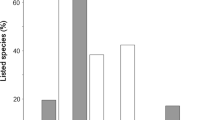Abstract
Data Deficient species (DD) comprise a significant portion of the total number of species listed within the IUCN Red List. Although they are not classified within one of the threat categories, they may still face high extinction risks. However, due to limited data available to infer their extinction risk reliably, it is unlikely that the assessment of the true status of Data Deficient species would be possible before many species decline to extinction. An appropriate measure to resolve these problems would be to introduce a flag of potentially threatened species within the Data Deficient category [i.e., DD(PT)]. Such a flag would represent a temporary Red List status for listed Data Deficient species that are, based on the available direct evidence and/or indirect indices, likely to be assigned to one of the threat categories, but where current data remains insufficient for a complete classification. The use of such a flag could increase the focus of the scientific community and conservation decision-makers on such species, thus avoiding the risk that necessary conservation measures are implemented too late. As such, establishment of the DD(PT) category as a kind of alarm for priority species could be beneficial.
Similar content being viewed by others
References
Bland LM, Collen B, Orme DL, Bielby J (2015) Predicting the conservation status of data-deficient species. Conserv Biol 29(1):250–259
Burgman MA, Grimson RC, Ferson S (1995) Inferring threat from scientific collections. Conserv Biol 9:923–928
Burgman MA, Maslin BR, Andrewartha D, Keatley MR, Boek C, McCarthy MA (2000) Inferring threat from scientific collections: power tests and an application to Western Australian Acacia species. In: Ferson S, Burgman MA (eds) Quantitative methods for conservation biology. Springer, New York, pp 7–26
Butchart SHM, Stattersfield AJ, Brooks TM (2006) Going or gone: defining ‘Possibly Extinct’ species to give a truer picture of recent extinctions. Bull BOC 126:7–24
Davidson AD, Hamilton MJ, Boyer AG, Brown JH, Ceballos G (2009) Multiple ecological pathways to extinction in mammals. Proc Natl Acad Sci USA 106(26):10702–10705
de Lima RF, Bird JP, Barlow J (2011) Research effort allocation and the conservation of restricted-range island bird species. Biol Conserv 144:627–632
Howard SD, Bickford DP (2014) Amphibians over the edge: silent extinction risk of Data deficient species. Divers Distrib 20(7):837–846
IUCN (2001) IUCN Red List Categories and Criteria. Version 3.1. http://www.iucnredlist.org. Accessed 10 May 2016
IUCN (2015) The IUCN Red List of Threatened Species. Version 2015-4. http://www.iucnredlist.org Accessed 10 May 2016
Jetz W, Freckleton RP (2015) Towards a general framework for predicting threat status of data-deficient species from phylogenetic, spatial and environmental information. Philos Trans R Soc Lond B Biol Sci 370(1662):20140016
Jones KE, Safi K (2011) Ecology and evolution of mammalian biodiversity. Philos Trans R Soc Lond B Biol Sci 366(1577):2451–2461
Luiz OJ, Woods RM, Madin EMP, Madin JS (2016) Predicting IUCN extinction risk categories for the world’s Data deficient groupers (Teleostei: Epinephelidae). Conserv Lett. doi:10.1111/conl.12230
McCarthy MA (1998) Identifying declining and threatened species with museum data. Biol Conserv 83:9–17
McInerny GJ, Roberts DL, Davy AJ, Cribb PJ (2006) Significance of sighting rate in inferring extinction and threat. Conserv Biol 20:562–567
Morais AR, Siqueira MN, Lemes P, Maciel NM, De Marco P, Brito D (2013) Unraveling the conservation status of Data deficient species. Biol Conserv 166:98–102
Quintero E, Thessen AE, Arias-Caballero P, Ayala-Orozco B (2014) A statistical assessment of population trends for data deficient Mexican amphibians. PeerJ 2:e703
Regan HM, Colyvan M, Burgman MA (2000) A proposal for fuzzy International Union for the Conservation of Nature (IUCN) categories and criteria. Biol Conserv 92:101–108
Robbirt KM, Roberts DL, Hawkins JA (2006) Comparing IUCN and probabilistic assessments of threat: do IUCN Red List criteria conflate rarity and threat? Biodivers Conserv 15:1903–1912
Roberts DL, Taylor L, Joppa LN (2016) Threatened or data deficient: assessing the conservation status of poorly known species. Divers Distrib 22(5):558–565
Rodrigues ASL, Pilgrim JD, Lamoreux JF, Hoffmann M, Brooks TM (2006) The value of the IUCN Red List for conservation. Trends Ecol Evol 21(2):71–76
Schipper J et al (2008) The status of the world’s land and marine mammals: diversity, threat, and knowledge. Science 322(5899):225–230
Sitas N, Baillie JEM, Isaac NJB (2009) What are we saving? Developing a standardized approach for conservation action. Anim Conserv 12:231–237
Acknowledgments
The authors acknowledge the sponsorship provided by the Alexander von Humboldt Foundation and the Federal German Ministry for Education and Research, as well as the support by the Invacost research program, and by the Project No. 173045, funded by the Ministry of Education, Science and Technological Development of the Republic of Serbia.
Author information
Authors and Affiliations
Corresponding author
Additional information
Communicated by David Hawksworth.
Rights and permissions
About this article
Cite this article
Jarić, I., Courchamp, F., Gessner, J. et al. Potentially threatened: a Data Deficient flag for conservation management. Biodivers Conserv 25, 1995–2000 (2016). https://doi.org/10.1007/s10531-016-1164-0
Received:
Revised:
Accepted:
Published:
Issue Date:
DOI: https://doi.org/10.1007/s10531-016-1164-0




